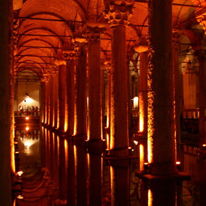
Latest News
New openings in 2025
The Zeyrek Cistern is opened to visits after years of restorations.
Entrance fees
As of 1st of March 2024, many State museums' fees are set in Euros, to be paid its equivalent in Turkish Liras.
Museum Pass
You can buy the "Museum Pass" for foreigners which is valid for 5 days in various museums of Istanbul.
Museums open 7 days
Many State museums in Istanbul operate 7 days a week, except Topkapi Palace.
Yerebatan Cistern
 The Yerebatan Cistern, Known as Yerebatan Sarayi (Sunken Palace) or Yerebatan Sarnici (Sunken Cistern) in Turkish, also known as Basilica Cistern by foreigners, was a major underground water reservoir in ancient Constantinople. Its name of "Basilica" comes from the fact that it was originally built beneath a Byzantine basilica, which was destroyed later on. This sight is one of the most impressive, mystical, greatest and magnificent ancient buildings of the city, located next to Hagia Sophia in the old city center.
The Yerebatan Cistern, Known as Yerebatan Sarayi (Sunken Palace) or Yerebatan Sarnici (Sunken Cistern) in Turkish, also known as Basilica Cistern by foreigners, was a major underground water reservoir in ancient Constantinople. Its name of "Basilica" comes from the fact that it was originally built beneath a Byzantine basilica, which was destroyed later on. This sight is one of the most impressive, mystical, greatest and magnificent ancient buildings of the city, located next to Hagia Sophia in the old city center.
The cistern was constructed in the 6th century AD during the reign of emperor Justinian I for water storage especially during probable enemy sieges, and is the largest surviving Byzantine cistern in Istanbul. The resevoir was once part of a great water network, including the aqueducts, started by the Romans and completed by the Byzantines and later by the Ottomans to supply the city and its palaces with running water. According to historical texts, over 7,000 slaves worked in the construction of this cistern.
After the conquest of Constantinople in the 15th century there was no need of such a huge cistern. During the Ottoman period it became a dumping ground for all sorts of junk, as well as corpses. Some parts were also destroyed by the earthquakes throughout the ages. Homes were built above it and local residents were obtaining water by lowering buckets into it. The cistern was cleaned and renovated by the Istanbul Metropolitan Municipality (IBB) and opened to the public as a tourist attraction in 1987. Final restorations were made recently and reopened to visitors in 2022.
Yerebatan cistern has a a rectangular shape; 140 meters (460 feet) long, 70 meters (230 feet) wide, and around 10 meters (33 feet) high, covering an area of 9,800 square meters (2,42 acres) in total. It was able to store up to 80-100 cubic meters (80-100 million liters, 100,000 tonns, or 21-26 million US gallons) of water. There are 336 marble and stone columns inside, each 9 meters (30 feet) tall, many of which were taken from ruined ancient temples and buildings. Erected at 4.80 meters (15 feet) intervals from one another the columns are composed of 12 rows, each having 28 columns. The column capitals bear different styles such as the Corinthian style or the Dorian style, being compiled from the ancient structures as well. The brick walls are almost 5 meters (16 feet) tick. The floor is covered by several layers of terracotta bricks and plastered by a thick layer of brick dust mortar for waterproof.
Since most of the columns are recycled from ancient structures, inside you can see many different types and styles; some of the columns are one piece, or two pieces, some are narrow and some are wider, and some are square or with decorations. One of the columns for example features engravings of a Hen's Eye and tears. Two of the columns rest on big marble blocks depicting Medusa, one of the three Gorgon sisters in Greek mythology with snakes hair. It is believed that they were taken from an old structure of late Roman period and reused in the construction of the cistern. One of these Medusa heads is upside-down and the other one is positioned sideways, for various reasons and belief.
Today, the Municipality organizes art exhibitions, small classic music concerts, light shows and other events inside for special occasions and on certain periods. There are many steps to go under and up, and also a platform for the accessibility. The admission to the cistern costs 1.300 TL. (Note that entrance fee after 19:00 is 2.000 TL)
Hope to see you soon in Istanbul.

